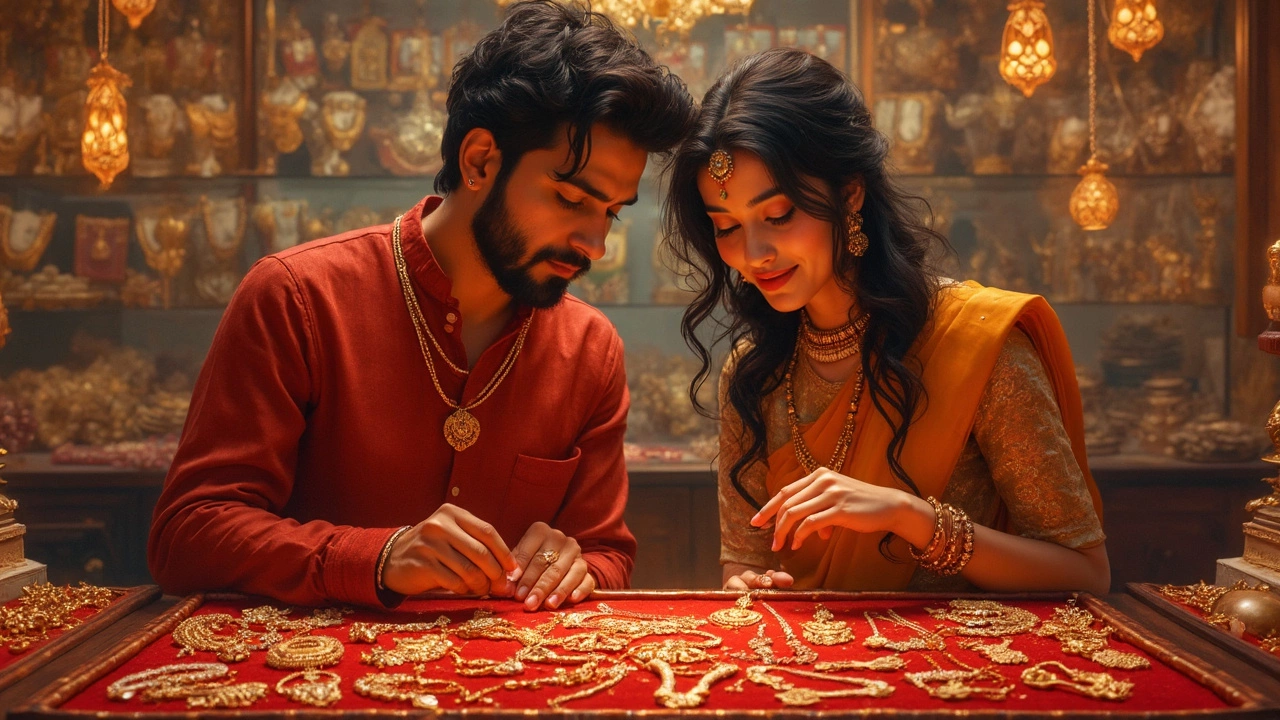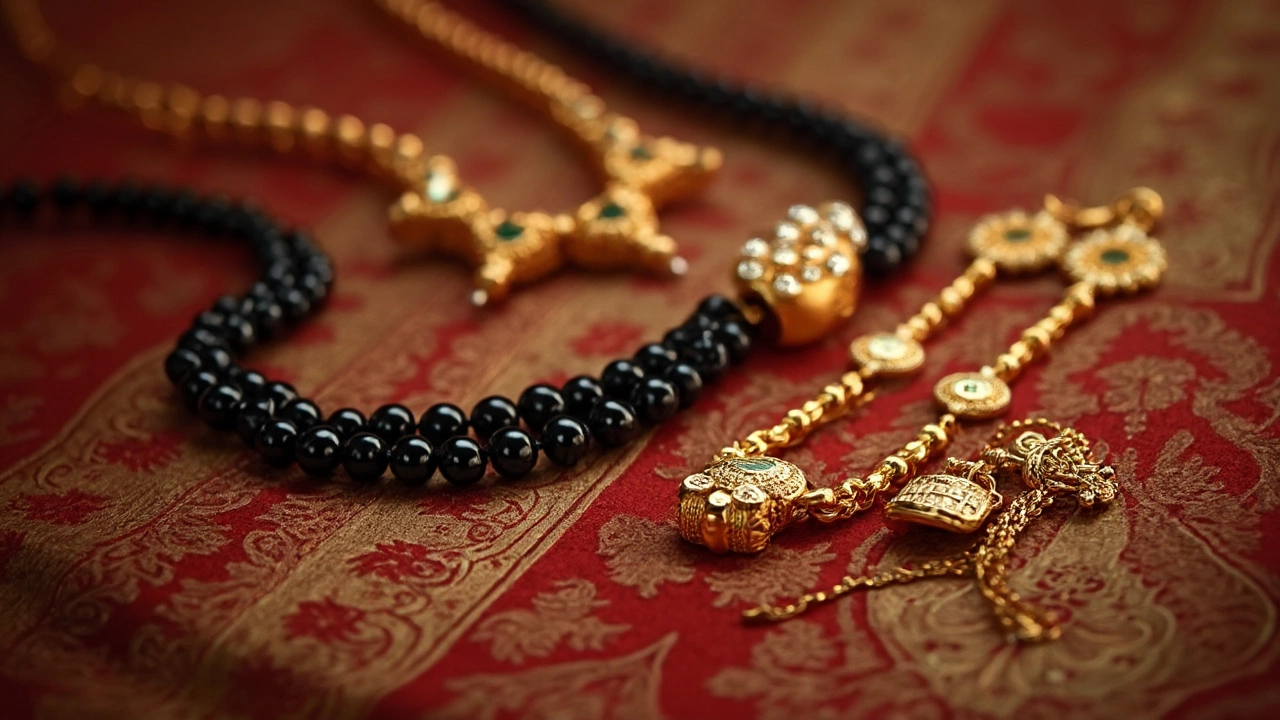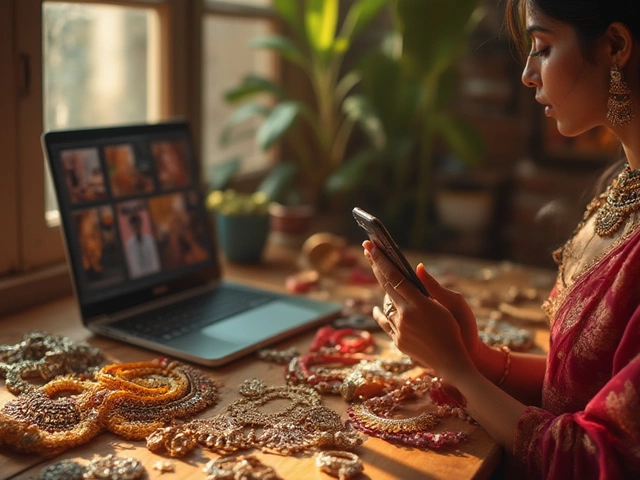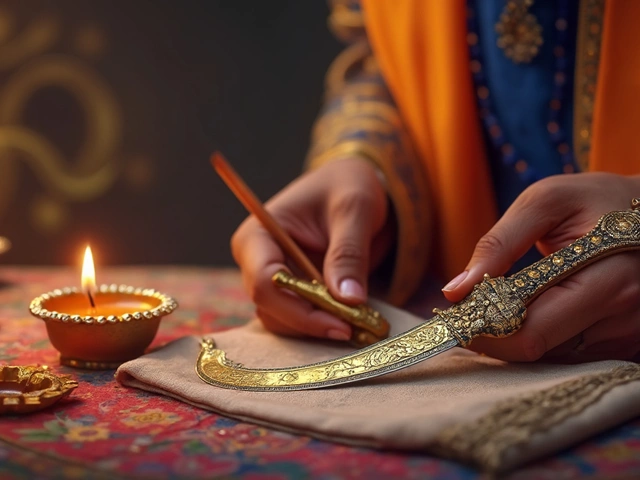Shopping for a mangalsutra isn’t just about picking something shiny. It’s a blend of tradition, personal style, and making sure it can actually keep up with your daily life. If you think all mangalsutras look the same, flip through any jewelry catalog and you’ll see the designs range from chunky, bold pieces loaded with black beads to sleek, simple chains that almost pass for everyday necklaces.
Before you drop money on one, focus on the kind of gold being used—the purity level actually matters for both looks and long-term durability. Are you leaning toward a modern look or sticking with the styles your mom swears by? There’s a big difference in how some designs fit into casual, office, or family settings. Can you wear it without fuss every day or will it constantly snag on your clothes? These are small details, but they matter way more than you think when you actually start wearing it.
- What Does a Mangalsutra Really Mean?
- Material: Not All Gold Is Equal
- Designs: Classic vs Modern
- Practical Stuff: Comfort and Safety
- Care and Everyday Wear Tips
What Does a Mangalsutra Really Mean?
The mangalsutra is way more than just a piece of jewelry. For a lot of Indian women, it’s almost like a wedding ring—a sign you’re married, and a promise of commitment and protection. Black beads and gold aren’t just for show; they’re meant to ward off negativity and keep both partners safe. Some people even believe it brings good luck to the couple’s life together.
If you look at traditions across India, the styles and customs can change in each region. In Maharashtra, women usually wear the classic two ‘vatis’ (small gold bowls) with black beads. Tamilians often go for yellow thread or thick gold chains. Northern states mix in diamonds or other gems. The design might look different, but the idea is always the same–it symbolizes the bond between partners.
| Region | Typical Mangalsutra Style |
|---|---|
| Maharashtra | Two vatis, black beads |
| Tamil Nadu | Yellow thread, gold pendant |
| North India | Gold, diamonds, gems |
| Gujarat | Gold chain, unique motifs |
Here’s what most people watch out for when it comes to the meaning of a mangalsutra:
- Respect for tradition, especially in older generations
- Clear sign of marital status, like a wedding band in the West
- You’re expected to wear it daily, not just during festivals or functions
Don’t feel pressured to go all out just because someone else has a heavy, elaborate mangalsutra. Today, a lot of women prefer simple designs that fit their lifestyle. But the main thing stays the same: wearing one is about marking a new chapter and showing pride in your relationship.
Material: Not All Gold Is Equal
Ever bought gold jewelry and wondered why some pieces look totally different after a year? The answer is usually in the purity. Mangalsutras are usually made with 22kt or 18kt gold, but people mix these terms up all the time. The higher the karat, the more pure the gold. But pure gold is actually softer, so a 22kt mangalsutra will shine and look great, but it might bend or scratch easier than an 18kt piece.
Here’s a basic breakdown:
| Gold Type | Purity % | Best For | Durability |
|---|---|---|---|
| 24kt | 99.9% | Bars, coins (too soft for jewelry) | Low |
| 22kt | 91.6% | Traditional mangalsutras | Medium |
| 18kt | 75% | Modern, stylish wear | Higher |
So, if you want a mangalsutra you can wear every day without stressing over scratches, 18kt makes more sense. For folks who want that pure gold look and don’t mind a little extra care, 22kt is the classic pick. Rarely, you’ll see 14kt options—they’re even tougher but look less yellow and more dull.
Another thing: don’t just check the gold. Look at the black beads and the lock system. If those aren’t sturdy, you might end up losing your precious mangalsutra during daily wear. Also, ask for a BIS hallmark. It’s the government's official stamp of purity and stops you from getting ripped off with fake gold. If you’re buying diamonds or other stones in your mangalsutra, double-check the certifications. Most jewelers can show you these details—don’t be shy about asking.
And here’s a small tip: thicker chains may cost a bit more but survive daily use way better than the super thin, delicate ones. When in doubt, imagine your life three years out—will your pick still look good after a few accidental yanks and a hundred showers?

Designs: Classic vs Modern
The look of a mangalsutra has changed a lot over the years. Some families want to stick with what’s been around forever: thick gold chains, twin pendants, and loads of black beads. It’s a symbol of marriage, and in many homes, the chunkier, the better. You’ll usually spot these traditional mangalsutras in places like Maharashtra and South India. The designs are loaded with meaning—like two vatis (bulb-shaped pendants) in Maharashtrian style or elaborate Lakshmi motifs in the South.
But scroll your Insta feed today and modern mangalsutras are a whole different ball game. You’ve got mangalsutra bracelets, delicate pendants shaped like hearts and infinity symbols, and super slim chains you can layer with your regular gold necklace. In fact, a survey by a leading jewelry brand in 2024 showed nearly 60% of Indian women under 30 went for minimalist, lightweight mangalsutras over the traditional ones. The reason? Comfort, everyday wear, and something that matches jeans as well as sarees.
If you’re confused about what fits, check this quick table for a side-by-side look:
| Type | Main Features | Best For |
|---|---|---|
| Classic | Heavy gold, multiple black beads, traditional motifs (Lakshmi, vati, coins) | Cultural ceremonies, family expectations, pairing with ethnic wear |
| Modern | Lightweight, sleek chains, unique pendants (hearts, diamonds, initials), bracelets, rings | Daily wear, mixing with western outfits, minimal fuss |
Honestly, there’s no ‘right’ choice—just what feels like you. If tradition matters to your folks, a classic design might be smoother at family functions. On the flip side, if you’re the kind who barely likes jewelry, a modern, understated mangalsutra will probably get worn, not just stay locked in the cupboard.
Practical Stuff: Comfort and Safety
The first thing nobody tells you—if a mangalsutra feels annoying even in the store, it won’t magically get better once you wear it at home. Comfort should be at the top of your checklist. Compare a chunky traditional chain against the newer lightweight designs. That classic, heavy look might look stunning, but it can get sweaty under a T-shirt or work top, especially during hot weather.
When it comes to safety, think about both the wear-and-tear of the mangalsutra and your own security. Thicker chains last longer, but they can also attract unwanted attention in crowded places. On the other hand, fragile, thin chains can snap if you tug them by accident or if they get caught on something. A smart workaround is to pick a design with solid clasps and a bit of flexibility in the links, not rigid ones that break with a pull.
- Try out different chain lengths—18 inches is pretty standard, but many women prefer 20-22 inches for daily wear.
- Flip the necklace and check the clasps. Lobster and spring-ring clasps usually last longer than simple hook types.
- If you find the beads prickly or rough, that's a sign you may need to switch to smoother, rounded or glass-coated beads.
Actual data shows wearers who pick light, flexible mangalsutras have fewer complaints about neck rashes and broken chains after one year compared to bulky designs. Here’s a quick peek at real numbers from a 2023 customer survey by a leading jewelry brand:
| Design Type | Complaints After 1 Year (%) | Common Issues |
|---|---|---|
| Chunky Traditional (20g+) | 23 | Heavy feel, chain breakage |
| Light Modern (8-15g) | 8 | Clasps, minor snagging |
Finally—if you do a lot of physical work or commute by public transport, tuck the chain under your outfit or choose a design that sits flat against your skin. Better safe than sorry.

Care and Everyday Wear Tips
Wearing your mangalsutra every day? There’s a bit to keep in mind if you want it looking the same years from now. Gold and black bead chains need a bit of TLC. Sweat, moisturizers, and rough handling can make them look old before their time—especially the lighter gold chains, which are easy to bend.
Here’s how you actually protect it:
- Take it off before going to bed if possible. Twisted chains are more common than you think, especially if you toss and turn.
- Keep it away from perfumes, deodorants, and lotions. Chemicals kill shine faster than daily soap.
- Clean it once a month. Warm water with mild soap and a soft toothbrush is all you need. Skip harsh jewelry cleaners with ammonia—they can ruin the beads and make the gold look dull.
- If yours has diamonds or stones, double-check the settings every few months. Lose a stone and the repair bills add up.
Here’s a quick look at common mangalsutra chain types and how tough they actually are:
| Chain Type | Durability | Special Care Needed? |
|---|---|---|
| Hollow Gold Chains | Low | Yes – bends/breaks easily |
| Solid Gold Chains | High | No – just regular cleaning |
| Bead Chains | Medium | Check for loose beads often |
Thinking about storage? Use a soft cloth pouch or a separate box. Dumping your mangalsutra in a regular jewelry box with other stuff is just asking for tangles and scratches. And if you don’t wear it daily, rotate it with your regular jewelry so the chain doesn’t stiffen or get kinks.
Losing a mangalsutra hurts—emotionally and financially. Take a photo and keep a copy of the purchase bill just in case. Some insurance plans let you claim jewelry, but you’ll need proof if anything goes missing.
If you actually want to keep the sentimental value, don’t just stash it after the wedding. Small, regular habits will make sure your piece looks just as special in year ten as it did on day one.



